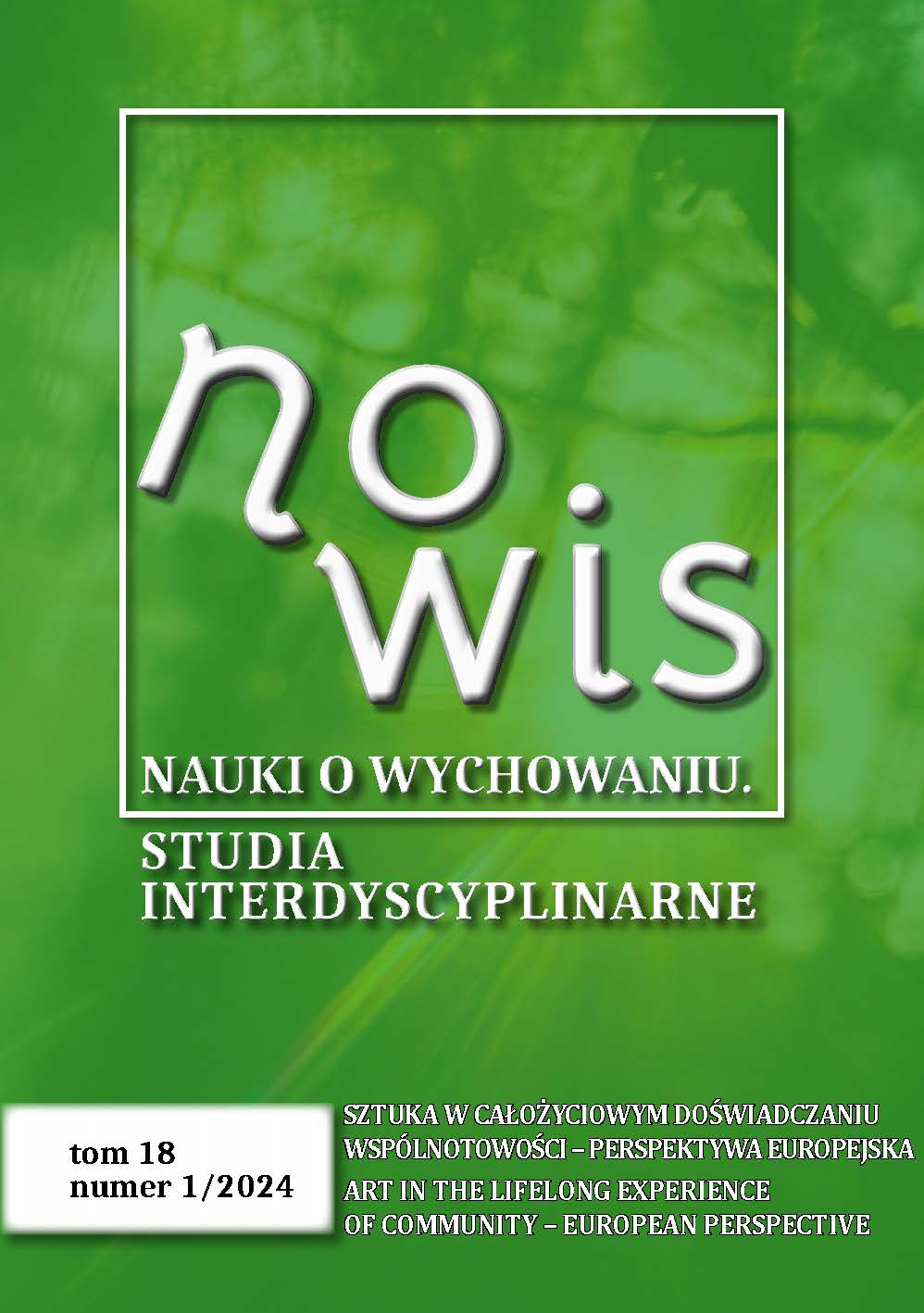Community of Sounds – Community of Culture. Sound in Social Situations
DOI:
https://doi.org/10.18778/2450-4491.18.14Keywords:
audiosphere, feeling of community, acoustic ecology, soundwalks, field recordingAbstract
This paper proposes a look at the community of culture from the viewpoint of the community of sounds, which is its immanent part. The sound environment is a significant element which builds a feeling of national, local, group, generational, and other affiliation and identity. Sounds may function as symbols, be a part of rituals, and carry values. Treating the audiosphere as an indicator of a community opens us to a new dimension of reflecting on the meaning of the sound landscape, understood, after R. M. Schafer, as the whole or a part of the sound environment with its perceptual, social, and historical-social context. Sound is the reflection of social organization systems created by people; therefore, social changes are reflected in the sound environment. In the analysis of this issue, I have used field recordings and their descriptions made by pedagogy students from the University of Lodz. The students’ observations confirm that it is worth reflecting on the sound in the ocularcentric world, which seems more than before dominated by sight, considered a sense of distancing by Wolfgang Welsch.
References
Amato J. (2002) Rethinking Home: A Case for Writing Local History, Berkeley, University of California Press, https://doi.org/10.1525/9780520936331
Google Scholar
DOI: https://doi.org/10.1525/9780520936331
Bernat S. (2008) Kierunki kształtowania krajobrazów dźwiękowych, “Prace Komisji Krajobrazu Kulturowego”, vol. XI, pp. 100–121.
Google Scholar
Bernat S. (2014) Turystyka dźwiękowa jako nowa forma turystyki zrównoważonej, “Zeszyty Naukowe. Turystyka i Rekreacja”, no. 1, pp. 25–39.
Google Scholar
Borawski A. (1921) O ludwisarstwie i dzwonach w Polsce, Kraków, published by M. Muzeum Przemysłowe im. A. Baranieckiego.
Google Scholar
Dziura M. (2019) Rola i znaczenie dźwięku dzwonów w kształtowaniu poczucia zadomowienia, “Journal of Urban Technology”, no. 17, pp. 259–278, https://doi.org/10.23858/JUE17.2019.016
Google Scholar
DOI: https://doi.org/10.23858/JUE17.2019.016
Guzy-Steinke H. (2010) Tradycja kulturowa jako przyczyna inkluzji społecznej in: Edukacja społeczna wobec problemów współczesnego człowieka i społeczeństwa, J. Piekarski, T. Pilch, W. Theiss, D. Urbaniak-Zając (eds.), Łódź, Wydawnictwo Uniwersytetu Łódzkiego, pp. 271–281.
Google Scholar
Hofstede G., Hofstede G. J., Minkov M. (2011) Kultury i organizacje, trans. M. Durska, Warszawa, Polskie Wydawnictwo Ekonomiczne.
Google Scholar
Kapelański M. (2005) Narodziny i rozwój ekologii akustycznej pod banderą szkoły pejzażu dźwiękowego, “Muzyka”, no. 2, pp. 107–118.
Google Scholar
Kołacki R. (2011) Prezentacja multimedialnego projektu Tonopolis. Rola krajobrazu dźwiękowego w turystyce miejskiej Torunia, “Prace Komisji Krajobrazu Kulturowego”, no. 15, pp. 206–212.
Google Scholar
Losiak R. (2010) O opisach pejzaży dźwiękowych, “Prace Kulturoznawcze”, vol. XI, pp. 224–232.
Google Scholar
Losiak R. (2012) Autentyczność dźwięków. Kulturowy kontekst schizofonii, “Kultura współczesna. Teoria, Interpretacje, Praktyka”, vol. 72, no. 1, pp. 94-101.
Google Scholar
Losiak R. (2017) Wokół idei ekologii akustycznej. Koncepcje i praktyki, “Studia Etnologiczne i Antropologiczne”, no. 17, pp. 115–126.
Google Scholar
Losiak R., Tańczuk R. (2015) Pejzaż dźwiękowy miejsca zamieszkania w doświadczeniu wrocławian, “Studia Etnologiczne i Antropologiczne”, no. 1, pp. 191–203.
Google Scholar
McLuhan M. (2004) Zrozumieć media. Przedłużenie człowieka, trans. M. Szczucka-Kubisz, Warszawa, Wydawnictwa Naukowo-Techniczne.
Google Scholar
Misiak T. (2009) Estetyczne konteksty audiosfery, Poznań, Wyższa Szkoła Nauk Humanistycznych i Dziennikarstwa.
Google Scholar
Misiak T. (2014) Sound studies. Badania na stykach in: Na stykach kultur i mediów. Między prowincjonalizmem a kosmopolityzmem, A. Kisielewska (ed.), Białystok, Wydawnictwo Uniwersytetu w Białymstoku, pp. 263–274.
Google Scholar
Misiak T. (2015) Spóźniony projekt ekologii akustycznej. Dźwięk jako fenomen kulturowy in: Więcej niż obraz, E. Wilk, A. Nacher, M. Zdrodowska, E. Twardoch, M. Gulik (eds.), Gdańsk, Wydawnictwo Naukowe Katedra.
Google Scholar
Olcoń-Kubicka M. (2009) Indywidualizacja a nowe formy wspólnotowości, Warszawa, Wydawnictwo Naukowe Scholar.
Google Scholar
Oliveros P. (2005) Deep Listening. A Composer’s Sound Practise, Bloomington, iUniverse.
Google Scholar
Ong W. J. (1992) Oralność i piśmienność. Słowo poddane technologii, trans. J. Japola, Lublin, Redakcja Wydawnictw KUL.
Google Scholar
Paine G. (2017) Acoustic Ecology 2.0, “Contemporary Music Review”, no. 36, pp. 171–181, https://doi.org/10.1080/07494467.2017.1395136
Google Scholar
DOI: https://doi.org/10.1080/07494467.2017.1395136
Pinch T., Bijsterveld K. (eds.) (2011) The Oxford Handbook of Sound Studies, New York, Oxford University Press, https://doi.org/10.1093/oxfordhb/9780195388947.001.0001
Google Scholar
DOI: https://doi.org/10.1093/oxfordhb/9780195388947.001.0001
Reymont W. (1977) Ziemia obiecana, Warszawa, Państwowy Instytut Wydawniczy.
Google Scholar
Rypiński M. (2013) Dźwięk jako element produktu turystycznego na wybranych przykładach, “Turystyka Kulturowa”, no. 8, pp. 24–37.
Google Scholar
Sasin M. (2021) Ekologia akustyczna jako istotny element nowoczesnej pedagogiki muzycznej, “Ars Inter Culturas”, no. 10, pp. 119–130.
Google Scholar
Sasin M. (2022) Stosunek do doznań słuchowych człowieka a świadomość ciała i cielesności. Perspektywa ekologii akustycznej, “Nauki o Wychowaniu. Studia Interdyscyplinarne”, vol. 14(1), pp. 58–72, https://doi.org/10.18778/2450-4491.14.05
Google Scholar
DOI: https://doi.org/10.18778/2450-4491.14.05
Schafer R. M. (1967) Ear Cleaning. Notes for an Experimental Music Course, Clark & Cruickshank, BMI Canada Limited.
Google Scholar
Schafer R. M. (1977) The Soundscape: Our Sonic Environment and the Tuning of the World, Rochester–Vermont, Destiny Books, Alfred A. Knopf.
Google Scholar
Schafer R. M. (1982) Muzyka środowiska, trans. D. Gwizdalanka, “Res Facta. Teksty o muzyce współczesnej”, no. 9, pp. 289–315.
Google Scholar
Sendyka R. (2011) Antropologia zmysłów, “Autoportret”, vol. 35(3), pp. 20–27.
Google Scholar
Szałasek F. (2017) Nagrania terenowe, Gdańsk, Wydawnictwo w Podwórku.
Google Scholar
Welsch W. (2001) Na drodze do kultury słyszenia? in: Przemoc ikoniczna czy „nowa widzialność”?, E. Wilk (ed.), trans. K. Wilkoszewska, Katowice, Wydawnictwo Uniwersytetu Śląskiego, pp. 56–74.
Google Scholar
European Capitals of Culture, https://culture.ec.europa.eu/policies/culture-in-cities-and-regions/european-capitals-of-culture (access: 19.09.2023).
Google Scholar
Hörstadt – Verein für Akustik, Raum und Gesellschaft, www.hoerstadt.at (access: 19.09.2023).
Google Scholar
Westerkamp H. (1974) Soundwalking, “Sound Heritage”, vol. III, no. 4, Victoria B.C., https://hildegardwesterkamp.ca/writings/writings-by/?post_id=13&title=soundwalking (access: 30.09.2018).
Google Scholar






 The journal's website, created and edited by the NOWiS Editorial Team on the Index Copernicus platform:
The journal's website, created and edited by the NOWiS Editorial Team on the Index Copernicus platform: 





